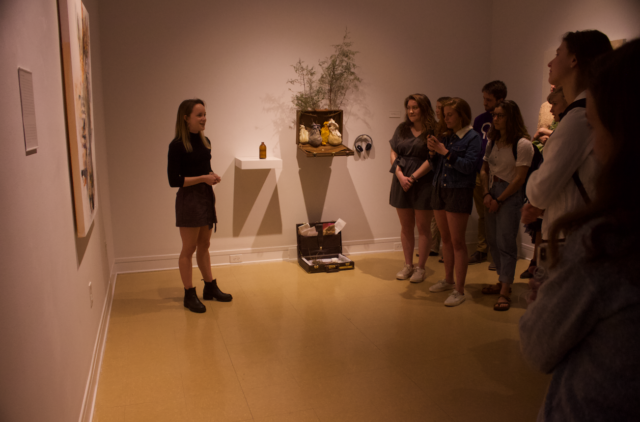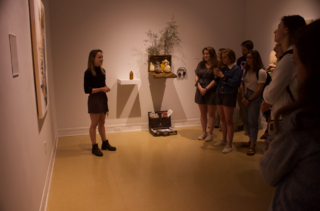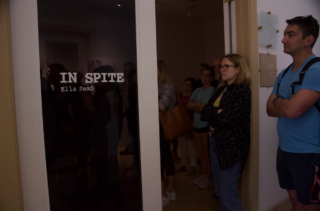An interview with Davidson Studio Art major Ella Sams ’20 by intern Alice Berndt ’22.
Name, Hometown: Ella Sams | Athens, Georgia
What is your primary medium?
I actually don’t have a primary medium. I will use whatever materials it takes to understand a life process or concept.
What was the inspiration for your show?
There were many moments of inspiration. Because the idea constantly evolved, I found inspiration up until the end. The main source of inspiration came from my work as a trip leader with Davidson Outdoors and as a volunteer at the Ada Jenkins Center. There were so many moments within those spaces where sensitivity to others was necessary. That sensitivity often opened me up to noticing connections.
What does the title of your show mean?
When the viewer reads the title, “In Spite,” there is a moment of shift. Some might read the title with the negative connotations of spiting someone, and others might read it with the positive connotations of persevering in spite of obstacles. I wanted the viewer to experience this in a shift from one to the other, and end up in a place of ambiguity and confusion. The reality of the phrase was not lost on me. Three hours after presenting my show on our ability to overcome communal struggles, we received the email to evacuate campus due to the largest communal struggle we’ve ever seen. “In spite” of the virus, life will continue, and we will learn from our experiences. Although my time at Davidson came to an end hours after my show, I am grateful for the opportunity I had, and I will continue in spite of the struggle.
What are the most important themes/concepts/ideas you want visitors to take away from this exhibit?
I want my viewer to feel empowered to find resilience in this time of uncertainty and anxiety. I want my viewer to identify with the struggle of at least one piece in the room. When I created my pieces, I imagined them to be mirrors. How could I leave my figures so obstructed that the viewer sees themselves? I created sculptures that could experience conflict like us. I want my viewer to feel conflict in themselves, and empathy for the pieces. Although the exhibit is closed, I want those who attended to remember that feelings are temporary, and we will grow from the struggle, just as the figures in my works continued despite the threat of fading away, or drying up.
What do you feel is the most significant piece in the exhibition and why? What is your favorite piece and why?
Because the moment of art in my work is the relationship between the viewer and the piece, I feel like it isn’t my space to decide which piece is the most significant. When I am the viewer in my exhibition, I find myself most emotionally drawn to the pieces related to my experience with the children at Ada Jenkins. It was a heavy experience to use my art to process secondary trauma, and to sum up the intense experience of love and challenge I’ve had working with the children, then hours after presenting having to evacuate Davidson permanently due to COVID-19. I never had the chance to say goodbye to them, and more importantly, they are not receiving the same resources as before now that we are in quarantine. It all felt too connected, and too relevant.
How was the installation process for you? Was it difficult to transition out of the studio and into a gallery space?
I’ve been thinking about installation since I wrote my exhibition proposal a year ago. I try to build an experience with my pieces, so I care a lot about the way they fit together for the viewer in the space provided. Of course, installation never runs as smoothly as planned. There were countless moments of frustration and uncertainty, but I felt blessed to have had the support of Lia Newman and David Sackett.
How will art and the process of making continue to play a role in your life after graduation?
The future has never been so unclear to me. I don’t know if I’ll have a job anymore with the way the virus has halted society. Before COVID-19 hit, I planned to start community art projects in the Asheville area alongside my work with Mountain Trail Outdoor School. I know there are many people out there struggling with the uncertainty of the workforce. I don’t know what the future holds anymore, but I know that art making is possible in any space, at any time, with any materials, and ANY person. This is the time for society to value art, and the capacity art has to help any one of us heal. I like to encourage people to think of themselves as artists. It’s a natural human act. My exhibition helped me overcome intense experiences, and I hope that it will help others overcome this societal experience.



